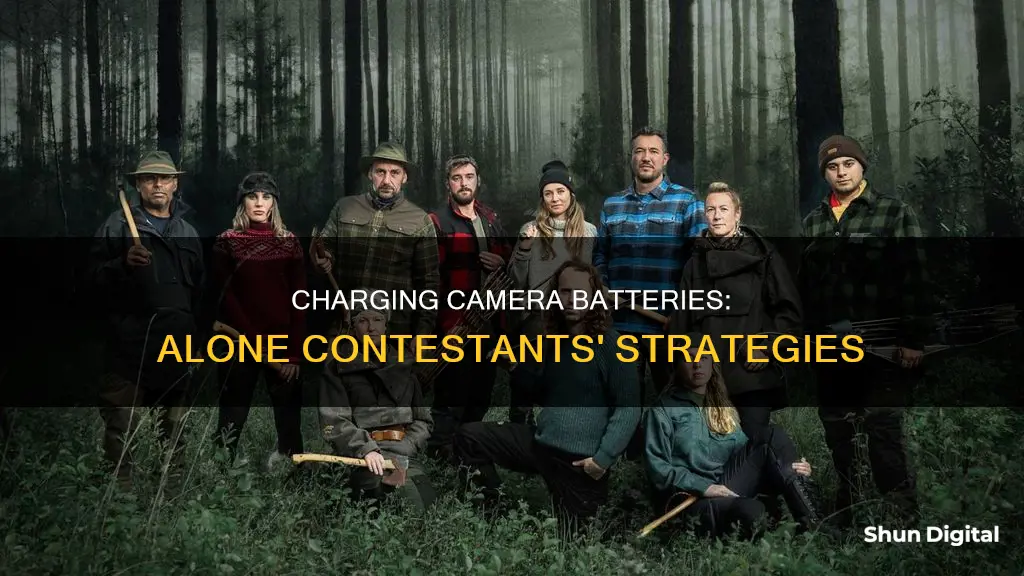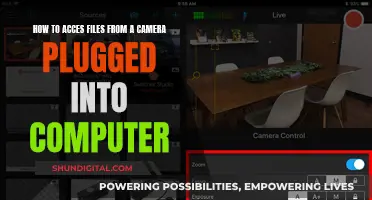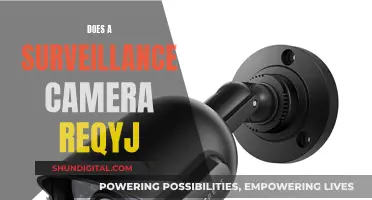
In the reality TV show 'Alone', contestants are left to survive in the wilderness with limited resources and no camera crew. They are responsible for filming their experiences themselves, and the footage is then used by the show's producers. As the contestants are truly alone, they do not have access to electricity to charge their camera equipment. Instead, they are provided with extra batteries and recharging stations by the show's crew, who visit them for medical check-ins and to collect footage every week or two.
| Characteristics | Values |
|---|---|
| How often are batteries changed? | Every week or two |
| Who changes the batteries? | A crew sent in by the directors |
| How many batteries are changed? | Enough to last until the next visit |
| What else is changed? | Memory cards |
What You'll Learn

Contestants get a weekly visit from a crew to swap batteries
Contestants on the show 'Alone' are given a weekly visit from a crew who swap their battery cameras. The crew also inspect their gear and give everyone new battery packs to ensure they are able to record every moment of their journey. The crew is dedicated to providing authenticity for the series.
During these visits, the crew are not allowed to talk to the contestants about anything beyond medical issues. Contestants are not allowed to ask about their favourite sports team, or socialise, for example, wish anyone happy birthday. The crew also do not provide any information on how the other contestants are doing.
The crew also use these visits to weigh the contestants as part of their medical check-up. The frequency of these medical check-ups increases as the show goes on and the number of contestants decreases. Executive Producer Shawn Witt explains:
> Once we get into day 45, day 50, day 60, and in some past seasons, way beyond that, simply because there's no medical precedent for that sort of survival situation with the lack of food, we cut it down to three or four days.
During season 2, second-place contestant Larry Roberts recalled that the intervention from production was minimal:
> They did check on us on a regular basis. We had a GPS tracker that we were required to carry. They would check in with us at least nightly, make sure that we were OK. They would send a very simple text that just said, 'Nightly check-in.' And we had a button with three presets, and we would just hit 'OK,' and just send it.
In season 5, contestant Sam Larson experienced a 12-day delay from the crew that was supposed to swap his batteries. They had been stranded in a mudslide that occurred in the backcountry.
Best Camera Battery Chargers: De-A45 Edition
You may want to see also

They carry extra batteries and get resupplied when needed
The contestants on the show Alone are given a couple of tarps to protect their camera gear from the elements. They are also responsible for keeping their camera equipment safe. To ensure that the contestants are able to record every moment of their journey, the crew comes in weekly to swap out their battery cameras.
Contestants carry extra batteries with them and are resupplied when needed. They are visited once a week for medical check-ups, and during these check-ins, they are given new batteries and USB cards. As the season progresses, contestants are given more batteries and recharging stations.
During a season 2 check-in, the crew went into contestant Larry Roberts' shelter, accessed his pelican camera case, and swapped out the batteries and memory cards while he waited outside.
In another instance, season 5 contestant Sam Larson experienced a 12-day delay in getting his batteries swapped out because the crew had been stranded in a mudslide in the backcountry.
Charging Camera Batteries: Do They Need a Full First Charge?
You may want to see also

They have to film themselves, and filming is part of the deal
Filming is a crucial part of the deal for contestants on the reality TV show "Alone." The show's premise involves contestants being left alone in the wilderness, without any camera crews following them. The contestants are responsible for filming themselves, and they must submit hundreds of hours of self-shot footage, which is then screened and edited by the show's production team. This footage provides an authentic record of the contestants' survival experiences and is a key component of the show's appeal and success.
To facilitate the filming process, contestants are provided with camera equipment, including batteries and memory cards, which they must use to document their experiences. The contestants are entirely responsible for operating and maintaining this equipment, including ensuring that the cameras remain charged. While the show's producers do provide support and intervene when necessary, the contestants are largely on their own when it comes to filming.
The contestants' ability to film themselves is essential to the show's format and premise. It allows viewers to witness the contestants' struggles, triumphs, and day-to-day lives as they navigate the challenges of surviving in the wilderness. This raw and unfiltered footage provides a sense of authenticity to the show, showcasing the contestants' survival skills, mental fortitude, and physical endurance.
The filming process is not without its challenges. Contestants must manage their time and energy effectively, as filming and maintaining the camera equipment can be time-consuming and physically demanding. Additionally, the cameras and equipment are vulnerable to the elements, and contestants must take steps to protect them from rain, extreme temperatures, and other environmental factors.
Despite these challenges, the contestants' dedication to filming themselves and providing comprehensive footage is a testament to their commitment to the show and their desire to share their unique experiences with the world. The filming process allows viewers to vicariously experience the contestants' journeys, offering a fascinating and educational glimpse into the world of survival and human resilience.
Charging Your GoPro: A Step-by-Step Guide
You may want to see also

The crew is far away, so contestants can't use them as a resource
The History Channel's "Alone" is a reality TV show that tests the survival skills of its contestants. The show is set in remote locations, and the contestants are left to survive with limited resources and no camera crew. The contestants are responsible for filming their experiences themselves, and this requires them to keep their camera equipment charged and in good condition.
The crew is far away from the contestants, and they cannot use them as a resource. The crew comes in once a week or once every two weeks to perform medical check-ins and swap out batteries and memory cards. The crew's distance from the contestants ensures that the contestants are truly alone and cannot rely on anyone but themselves.
Executive producer Ryan Pender confirmed that the crew is at least half an hour to an hour away from the contestants. This means that the contestants cannot rely on the crew for immediate assistance or support. They are truly on their own and must use their skills and resources to survive.
In addition to the weekly or bi-weekly crew visits, the contestants also have a GPS tracker and an old cell phone for emergencies. The GPS tracker allows the crew to check on the contestants' location regularly and perform nightly check-ins via text message. The old cell phone can only be used in emergency situations and does not provide much assistance beyond that.
The distance between the crew and the contestants is an essential aspect of the show's premise. It ensures that the contestants are truly isolated and must rely on their survival skills and resources. While the crew is on hand to provide medical support and equipment maintenance, they are not readily available, and the contestants must be self-sufficient.
The show's format and the crew's distance from the contestants create a challenging and authentic survival experience for the participants.
GoPro 6 Black: Charging and Camera Functionality
You may want to see also

The crew checks in with contestants at least nightly
These check-ins are vital to ensure the safety of the contestants, who are truly alone in the wilderness. While the crew is far enough away that contestants cannot use them as a resource, they are still within a half-hour to an hour response time in case of emergencies.
In addition to the nightly check-ins, the crew also conducts medical checks. In the early days of isolation, these checks happen weekly, but as the show progresses and the number of contestants decreases, the frequency increases to every three or four days for safety reasons. During these medical checks, contestants' blood oxygen level, heart rate, weight, temperature, and other vital signs are monitored.
The crew also plays a role in ensuring the contestants' camera equipment remains operational. As there are no camera crews following the participants, the contestants are responsible for filming their own experiences. The crew visits the contestants weekly to swap out battery cameras and memory cards, ensuring they can continue documenting their journey.
While the crew provides support through check-ins, medical checks, and camera maintenance, the contestants are ultimately on their own in the wild, testing their survival skills and endurance.
Best Buy's Camera Battery Charger Options Explored
You may want to see also
Frequently asked questions
The contestants on Alone are not provided with electricity to charge their camera equipment. Instead, the production team sends in a crew to change their batteries for them.
The participants get a weekly visit from a crew who come to swap their battery cameras for them.
Sam Larson, a participant in season 5, once experienced a 12-day delay when the crew that was supposed to swap his batteries got stranded in a mudslide.
No, the batteries are stored in a pelican camera case, which the crew has access to during the swap.
Yes, there are no camera crews following the Alone participants. They are required to film themselves as part of the deal of being on the show.







